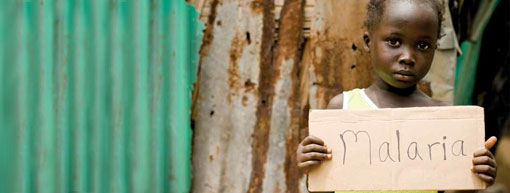Simon Cotton reports on the innovative research methods being employed to combat one of the world's most deadly diseases.
The spectre of malaria continues to loom large in the panoply of global disease. From optimistic reports earlier this year, suggesting a ‘revolutionary’ vaccine may be on the horizon, to environmentalists raising the worrying prospect of malarial mosquitoes taking up residence in UK water butts, the disease remains in the headlines.

We think of malaria as a tropical disease, but it was certainly endemic in certain regions of Britain 500 years ago. In the Fens, coastal and estuarine regions of East Anglia and the south of England in particular it was referred to by names such as the ‘ague’. In The Tempest, when Shakespeare refers to ‘All the infections that the sun sucks up from bogs, fens flats’, he means malaria. It was only stamped out by a combination of two factors – drainage of the Fens and the discovery of quinine.
Although precious metals like gold and silver were higher on their agenda, Spanish explorers in South America discovered quinine, an extract from the bark of cinchona trees that was active against malaria, which the Jesuits then brought back to Europe. Smuggled cinchona seeds led to the plantations in Dutch Java; without the ready availability of quinine, many tropical enterprises like the building of the Panama Canal would not have been feasible.
With the passing of time, some malarial parasites became resistant to quinine, so as synthetic organic chemistry developed, chemists devised man-made antimalarial molecules like quinacrine (Mepacrine, Atabrine), chloroquine (in use from 1947) and, in the 1960s mefloquine (Lariam). Quinacrine was widely used by Allied forces in tropical areas during the Second World War after the Japanese occupied Java and cut off the quinine supply pipeline, though it could have unpleasant side effects. Your skin and urine turning yellow was harmless, but the attempted suicide in 1941 of Orde Wingate (he was subsequently leader of the Chindits in Burma) has been attributed to a toxicpsychosis after overdosing on mepacrine. Chloroquine was less toxic than mepacrine and also required lower doses; it came into widespread use around the time of the World Health Organisation’s Global Malaria Eradication campaign from 1955, which was largely based upon DDT spraying. Strains of the Plasmodium falciparum parasite resistant to chloroquine were soon detected, and are now widespread through much of the world, including Africa and South-East Asia. By the early 1970s mefloquine was coming into wider use, for example with American troops fighting in Vietnam.
In fact, the next breakthrough in antimalarials occurred as a consequence of the Vietnam War. Malaria was decimating the ranks of the Vietcong forces, so Ho Chi Minh, leader of the Vietcong, appealed to China for antimalarials. It was the height of the Cultural Revolution, when intellectuals were sent to learn from the peasants but nevertheless a special unit of 600 scientists was set up to tackle the problem (‘Project 523’). They consulted 2,000-year-old manuals of herbal medicine and from one, rejoicing in the title of Emergency Prescriptions Kept up One’s Sleeve, by Ge Hong (284–363), they identified qinghao, obtained from the sweet wormwood plant Artemisia annua as a remedy for fevers. Rural Chinese peasants had either chewed a mixture of the herb and sugar or made a tea from it, using hot water, but in 1972 the researchers found that low-temperature extraction using ether as the solvent yielded a potent material that was more effective against malaria than chloroquine, obtaining colourless crystals of what is now known as artemisinin. The following year it was found that the dihydroartemisinin derivative was even more potent. This was, of course, undertaken as a secret military project, and the research did not emerge in the West until the end of that decade; the work received recognition when the head of the research team, Professor Youyou Tu, received the Lasker-DeBakey Clinical Medical Research Award in 2011.
Artemisinin is a remarkable molecule.It contains a very unusual peroxide bridge,and because people expected that tomake the molecule very unstable, thisdiscovery was initially greeted in the Westwith some scepticism. The peroxide linkageis believed to be key to its activity, thoughthe mechanism is still not understood.Chemists have used artemisinin as a leadmolecule to make derivatives such asartesunate or artemether that are evenmore effective (in the same way thatsemi-synthetic penicillins like amoxycillin and ampicillin are more useful thanbenzylpenicillin, the original form).
Artemisinins are now the approved treatment for malaria. In some places like Cambodia, there are reports of developing resistance of the parasite to artemisinins, at least in part due to poor quality medications, so that the World Health Organisation has recommended that artemisinin combination therapies (ACTs) be employed involving a mixture of an artemisinin-type molecule in combination with another antimalarial, such as lumefantrine or mefloquine. These combinations are fast-acting and only require a three-day treatment.
Chemists are not sitting back, though. For several years they have been investigating wholly synthetic molecules, which tend to be known by names like OZ 439 or RKA182. These are inspired by the artemisinins and also contain peroxide groupings; some have gone into clinical trial. Last year, a new family of potential anti-malarial synthetic drugs known as quinolone-3-diarylethers was reported. These do not contain the peroxide grouping and are believed to act against both the liver and blood stages of the parasite. One molecule, known as ELQ-300, has many desirable qualities, and is currently being evaluated in a preclinical setting, before clinical trials can begin.
Malaria isn’t just something that could spoil your holiday; it can be deadly. Malaria kills more than a million humans a year, mainly desperately poor people in Africa. No other justification is needed for combating it. Chemists and nature working together are a potent combination, and in the malaria parasite they have a worthy antagonist.
Dr Simon Cotton is Honorary Senior Lecturer in Chemistry at the University of Birmingham